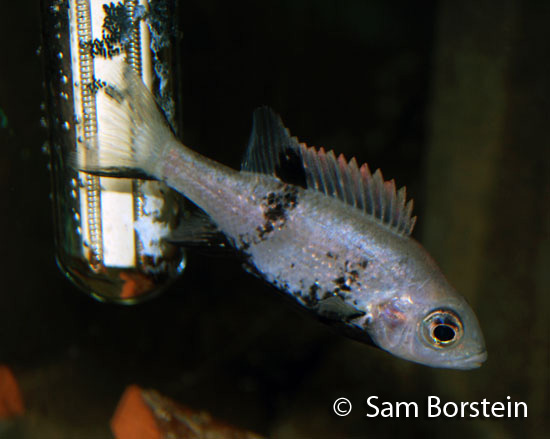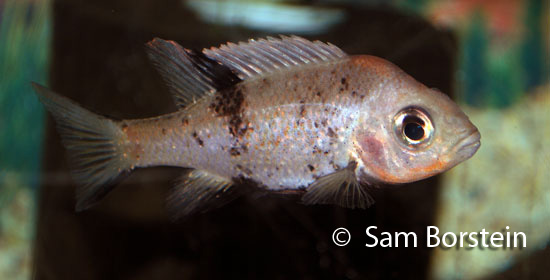Katria katria
(Reinthal & Stiassny, 2006)
Synonyms: Ptychochromoides katria



Above: A male Katria katria "Nosivolo River". Photo by Sam Borstein.
Etymology:
Genus- Katria= A native Madagascan name for the species.
Species- katria= A native Madagascan name for the species.
Intro:
Katria katria is an enigmatic riverine cichlid endemic to Madagascar which was originally described as Ptychochromoides katria by Reinthal and Stiassny in 1997. In 2006, with the benefit of molecular analysis, Stiassny and Sparks moved this very interesting cichlid into the monotypic genusKatria. The main difference between Katria and Ptychochromoides is the coloration pattern and tooth and gill raker characteristics. Nourisat and De Rham reported a similar species from the Namorona River, but it is thought that this fish has been extirpated from the region and it has not been investigated further.
Katria katria is an attractive fish which can reach lengths of 5-6 inches. The main body color is a bronzy-orange body color, stretching to the mouth of the fish. The fish have a nice contrast with black markings and silver spots. Fins tend to be black. Male coloration is stronger than female. Males may develop an impressive nuchal hump.
Katria katria is listed as a vulnerable species by the IUCN.
Distribution:
Katria katria is endemic to the Nosivolo river in Madagascar. The river is very fast moving and littered with rocks. There is very little aquatic plant life. However, Katria katria is found in the slower flowing areas of the river.
de Rham and Nourissat (2002) also state this species or a very close relative may have occurred in the upper Namorona River due to reports by local fisherman. However, it is thought that this species is most likely extinct from that river.
Size, Maturity, and Sexual Dimorphism:
Size: Males- 6 inches, Females- 5 inches
Maturity: 3 inches
Sexual Dimorphism: Males are larger and develop a distinct nuchal hump. Males also have a stronger bronze-orange color than females.
Care:
Katria katria can be highly aggressive and therefore needs a larger tank. I recommend a six foot tank for a group. It’s also a good idea to put in some durable, yet non-aggressive dither-target fish. I found some milder mbuna to work well.
Katria katria, like many Madagascan fish, enjoy high temperatures. I recommend keeping them at a minimum of 78F, but they seem to do best at the 82-84 degree range. Another concern when keeping this fish is that it comes from a riverine environment which means that Katria katria have high oxygen demands. While they need a lot of dissolved oxygen in the water, they don’t need a lot of current. I had four sponge filters running a lot of air in a 110 gallon for my fish. Katria katria do require good water quality. Large weekly water changes of 50-75% are recommended.
Diet:
Katria katria is easy to feed and accepts a vast array of food. Mine enjoyed a diet of spectrum, spirulina flake, and a mixed vitamin flake as well as the feeding of bloodworms and brine shrimp on occasion.
Breeding:
Katria katria become sexually reproductive around three inches. Katria katria can be a bit of a challenge to breed and are probably best suited for the advanced hobbyist.
The fish change color before breeding to a color pattern reminiscent of Hericthys of Mexico; a white upper body and a black lower body. In the wild, these fish like to lay their eggs on hard surfaces and in the shallows. Lots of digging is witnessed before spawning and the fishes tubes will also be down for about a week while the fish are courting. Katria katria can lay about 250-500 eggs.


Above: A female Katria katria in breeding color guarding fry (left) and a male in breeding color (right). Photos by Sam Borstein.
Katria katria are good parents and guard the eggs and fry very well. The female will stay over the eggs and fry while the male defends the territory. My fish laid their eggs on a small terracotta tile and also up the side of an adjoining rock in a cave structure I built for them.

Above: a female Katria katria guarding eggs.
The eggs hatch in about three days and in another 3-4 days are free swimming. The fry are small, but capable of consuming newly hatched baby brine shrimp. It is very interesting to see the female communicate with the fry via fin flicks and how they respond to her jet black pelvic fins. The fry are easy to raise, but grow relatively slowly until they hit an inch and then they have a bit of a growth spurt and then slow down again.
Conclusion:
Katria katria is a truly unusual fish that is worth keeping. Like all Madagascan cichlids, this species really needs our help as it may not be found in the wild for much longer. Sadly, Katria katria is not a very popular aquarium fish and is extremely rare to find in the hobby.
References:
- de Rham, P. and J-C. Nourissat (2002) The endemic cichlids of Madagascar. 1st ed., French Cichlid Association, St. Julia, France, 191 pp.
- Reinthal, P.N. and M.L.J. Stiassny (1997)Re vision of the Madagascan genus Ptychochromoides (Teleostei: Cichlidae), with a description of a new species. Ichthyol. Explor. Freshwaters 7(3-4): 353-368.
- Stiassny, M.L.J and J.S. Sparks (2006) Phylogenetic and taxonomic revision of the endemic Malagasy genus Ptychochromis (Teleostei: Cichlidae), with description of five new species and a diagnosis for Katria, New Genus. American Museum Novitates 3535, 1-55.
